Main menu
Common skin conditions

NEWS
Join DermNet PRO
Read more
Quick links
Cutaneous adverse reactions to calcineurin inhibitors — extra information
Cutaneous adverse reactions to calcineurin inhibitors
Author: Dr Jacqueline Deen, Dermatology Principal House Officer, Royal Brisbane and Women’s Hospital, Brisbane, QLD, Australia. DermNet Editor in Chief: Adjunct A/Prof. Amanda Oakley, Dermatologist, Hamilton, New Zealand. Copy edited by Gus Mitchell. November 2019.
Introduction Uses - topical calcineurin inhibitors Uses - oral calcineurin inhibitors Cutaneous side effects - topical calcineurin inhibitors Cutaneous side effects - oral calcineurin inhibitors
What are calcineurin inhibitors?
Calcineurin inhibitors are drugs that work by inhibiting the calcium-dependent protein phosphatase calcineurin, an enzyme that results in activation of T lymphocytes through the upregulation of interleukin-2 and related cytokines, and leads to immunosuppression [1].
- The oral calcineurin inhibitors are ciclosporin and tacrolimus.
- Topical calcineurin inhibitors are tacrolimus (available as 0.03% or 0.1% ointment) and pimecrolimus (1% cream) [2,3].
What are topical calcineurin inhibitors used for?
The calcineurin inhibitors tacrolimus and pimecrolimus are indicated for the treatment of atopic dermatitis.
They are commonly used off-label in dermatology for:
- Facial, flexural, and genital psoriasis
- Seborrhoeic dermatitis
- Chronic hand dermatitis
- Contact dermatitis
- Vitiligo
- Morphoea
- Lichen sclerosus
- Cutaneous lupus erythematosus
- Oral and erosive vulval lichen planus [2,4].
Topical calcineurin inhibitors are free of many adverse effects of topical corticosteroids, such as striae, cutaneous atrophy, glaucoma, rebound flares and systemic absorption, or the potential for hypothalamic pituitary–adrenal axis (HPA) suppression.
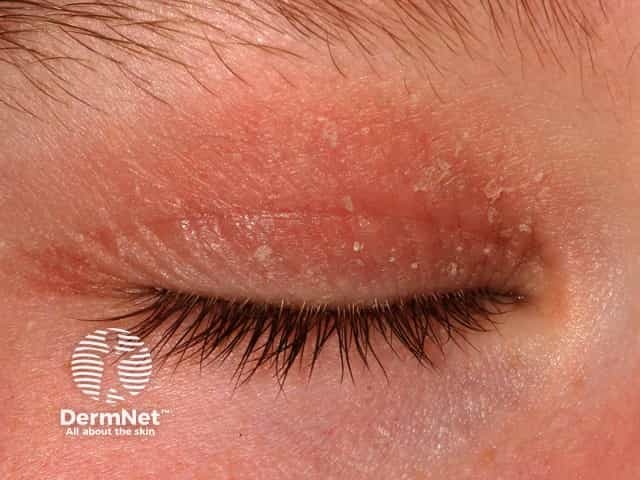
Atopic dermatitis of the eyelid
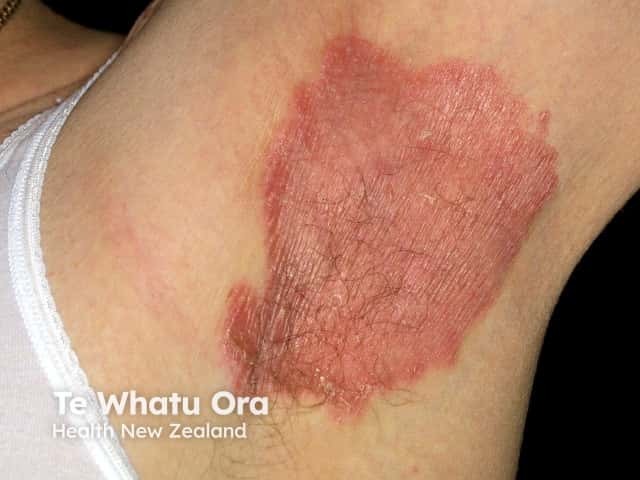
Flexural psoriasis

What are oral calcineurin inhibitors used for?
Oral calcineurin inhibitors are commonly used for immunosuppression after solid organ transplantation. Occasionally, ciclosporin and tacrolimus may also be used to treat immune-mediated diseases including psoriasis and atopic dermatitis; however, their use is mainly restricted to patients who have failed to respond to conventional therapy [3].
What are the cutaneous side effects of topical calcineurin inhibitors?
The most commonly reported side effect of topical calcineurin inhibitors is local skin irritation (burning, pruritus, and erythema) at the application site. However, this is usually transient and decreases over time (usually within one month).
Other adverse effects may include:
- Allergic contact dermatitis
- Folliculitis
- Reactivation of infection (herpes simplex and viral warts)
- Enhancement of facial flushing after alcohol ingestion
- Rosacea-like dermatitis
- Facial acne
- Molluscum contagiosum
- Tinea incognito.
There is no evidence to support the theoretical concern that topical calcineurin inhibitors may increase the risk of malignancy, such as basal cell carcinoma, cutaneous squamous cell carcinoma, melanoma and cutaneous lymphoma. Information reporting this risk is based on data from animal studies, case reports in a small number of patients, and knowledge of how these drugs work [2,4,5].
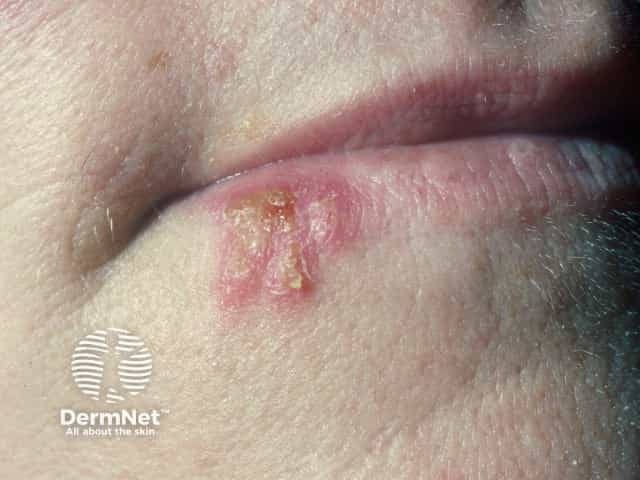
Herpes simplex labialis

Perioral dermatitis
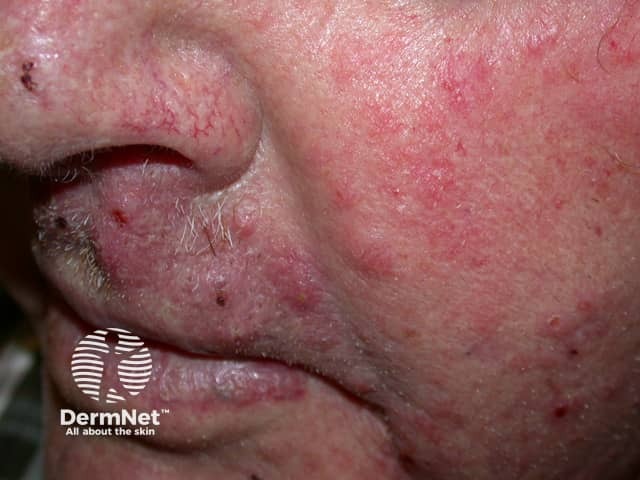
Tinea incognita - face
What are the cutaneous side effects of oral calcineurin inhibitors?
The adverse effects of tacrolimus and ciclosporin are generally similar. These include:
- Gingival hyperplasia
- Hypertrichosis (this is more common with ciclosporin)
- Drug-induced alopecia (higher doses of tacrolimus and ciclosporin are associated with an increased risk of hair loss)
- Drug-induced pruritus
- Drug-induced acne
- Flushing
- Generalised hyperhidrosis
- An increased risk of cutaneous squamous cell carcinoma [1,3].
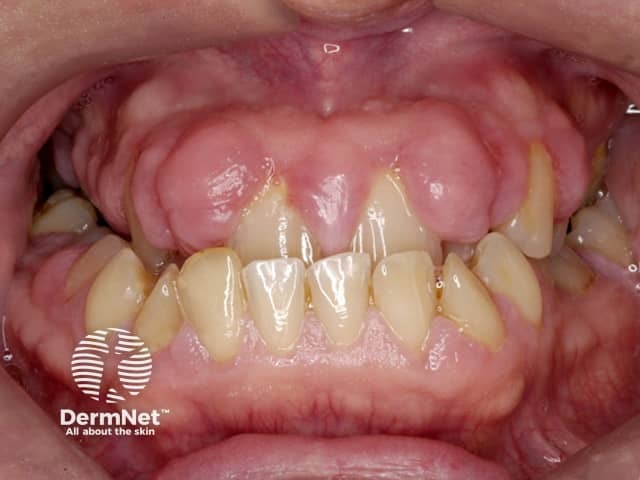
Gum hypertrophy due to ciclosporin

Hypertrichosis
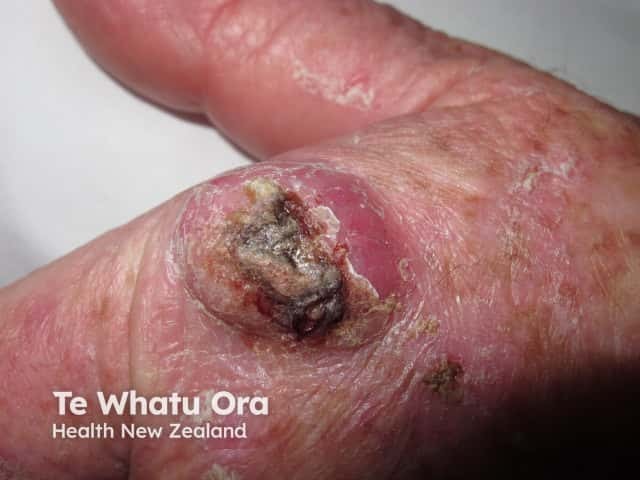
Cutaneous squamous cell carcinoma
References
- Malvezzi P, Rostaing L. The safety of calcineurin inhibitors for kidney-transplant patients. Expert Opin Drug Saf. 2015;14(10):1531–46. doi:10.1517/14740338.2015.1083974. PubMed
- Sehgal VN, Srivastava G, Dogra S. Tacrolimus in dermatology-pharmacokinetics, mechanism of action, drug interactions, dosages, and side effects: part I. Skinmed. 2008;7(1):27–30. doi:10.1111/j.1540-9740.2007.06485.x. PubMed
- Azzi JR, Sayegh MH, Mallat SG. Calcineurin inhibitors: 40 years later, can't live without ... J Immunol. 2013;191(12):5785–91. doi:10.4049/jimmunol.1390055. Journal
- Fleischer AB Jr, Boguniewicz M. An approach to pruritus in atopic dermatitis: a critical systematic review of the tacrolimus ointment literature. J Drugs Dermatol. 2010;9(5):488–98.PubMed
- Undre NA, Moloney FJ, Ahmadi S, Stevenson P, Murphy GM. Skin and systemic pharmacokinetics of tacrolimus following topical application of tacrolimus ointment in adults with moderate to severe atopic dermatitis. Br J Dermatol. 2009;160(3):665–9. doi:10.1111/j.1365-2133.2008.08974.x. PubMed
On DermNet
Other websites
- Calcineurin inhibitors — British Association of Dermatologists
